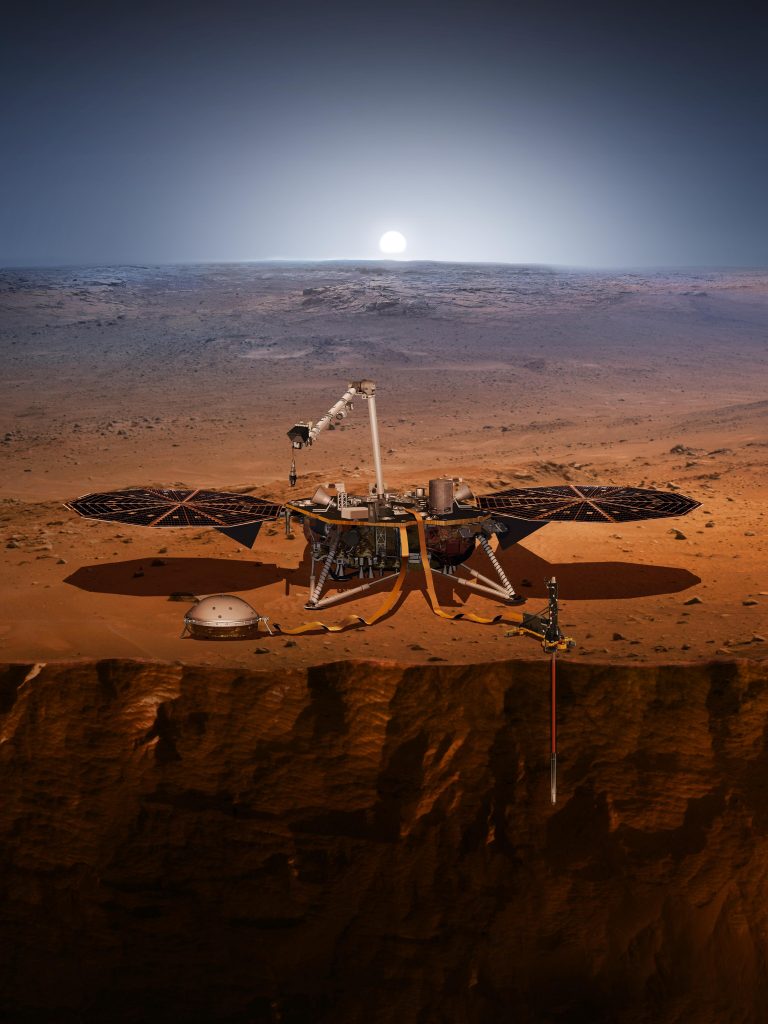With NASA missions to Mars stemming back to the 1960s, there has been a lot of data collected on the Red Planet. From fly-bys to orbiters to landers to rovers, there have been missions to study the topography, geology, atmosphere, soil composition, life readings, ice deposition – the list goes on and on. But so far, none of the missions has been equipped to study the internal geologic structure of Mars.
In a historic series of firsts, NASA and the Jet Propulsion Laboratory, in conjunction with Institut de Physique du Globe de Paris (Institute of Earth Physics of Paris) and Deutsches Zentrum für Luft- und Raumfahrt (German Aerospace Center), launched InSight last Friday from Vandenberg Air Force Base in Lompoc, California.
This is a mission full of firsts. Interplanetary missions have always been launched from Cape Canaveral in Florida, because the natural rotation of the Earth gives the rocket a boost when heading away from the planet. But now, thanks to the powerful Atlas V rocket and the lightweight InSight lander, the first-ever west coast interplanetary launch was possible.
“It’s like jumping off of a rotating disc going in the direction of the disc is going, so you get a little extra speed off it and it makes it a little easier. You don’t have to have quite as large a vehicle or quite as much power in your vehicle,” said Scott Messer, NASA Missions Program manager for United Launch Alliance, at the pre-launch press conference. “In this case, because the Atlas V 401 had enough performance, we are able to do that off the west coast. We’ll kind of go in the opposite direction initially; we’ll jump off the world going in the opposite direction that it spins and head south. We won’t get to take as much advantage of the rotation of the Earth [as when we launch from Florida].”
For JPLers, a west coast launch means they can attend the actual launch site events with less hassle. Elizabeth Barrett, Science System engineer for InSight at JPL, was one of the team members who drove up to see the launch. But unfortunately, as is common with early mornings on the Central Coast, she didn’t see much.
“Unfortunately the area where we had the majority of the viewing was encased in a cloud, so the fog was pretty intense and you couldn’t see anything visually. However, they did have screens up that were displaying the NASA TV coverage of the launch so the crowd could watch it on the TV screens. What was even better was, as it took off, you could feel and hear the thump of the rocket engines as it went into the sky. So at least you got to participate in that way,” Barrett said. “And more importantly, you were with the people who constituted the entire team that worked on the project, our foreign partners, our partners at JPL and our family, so that made it even better.”
The mission will be the first lander to carry a heat flow meter, which burrows into the surface of the planet and measures the heat coming off the core, a radio science experiment that will use the radio on the spacecraft to measure the small variations in the wobble of the Mars’ pole to understand more about the composition and structure of the core, and a seismometer that will be used to detect and measure Marsquakes.
“It’s going to Mars to do the science, to make the measurements that, scientifically and personally, I’ve been waiting over 30 years for,” said Bruce Bannerdt, InSight principal investigator at JPL, in a statement before launch. “As a graduate student, I was doing research on Mars and I just needed to have the thickness of the crust, and I didn’t have it. Seismology is the way to do it, so I thought, ‘Well maybe someday someone will put a seismometer on Mars and get this measurement so I can do my research.’ So it’s kind of an amazing journey for me to look back and say, ‘I’m the guy who’s actually going to put that seismometer on Mars to get that information.’ Now I can go back and finish the job I was trying to do 30 years ago. It’s an amazing feeling.”
The mission is slated to be one of the longest missions to run with only solar arrays. And despite that only 40% of the total missions sent to Mars by any space agency have been successful, hopes are high that InSight will outlive its mission lifetime.
“The primary mission is planned to be one Mars year, which is about two Earth years; however, there’s no limitation to her lifetime,” said Tom Hoffman, InSight project manager at JPL, in a pre-launch statement. “So we could last as long as we’re getting power from the solar arrays. As long as Mars is behaving itself, we’ll be able to survive and we’ll continue to get the scientific data back that the scientists have been craving for such a long time.”
InSight launched successfully through the fog on Friday and is now on its six-and-a-half month journey to the Red Planet, expecting to arrive on Nov. 26, 2018.
“We look forward to it, we’re going to be landing the Monday after Thanksgiving, so it’s something we’ll all be very thankful about,” Barrett said.

